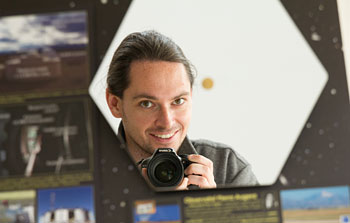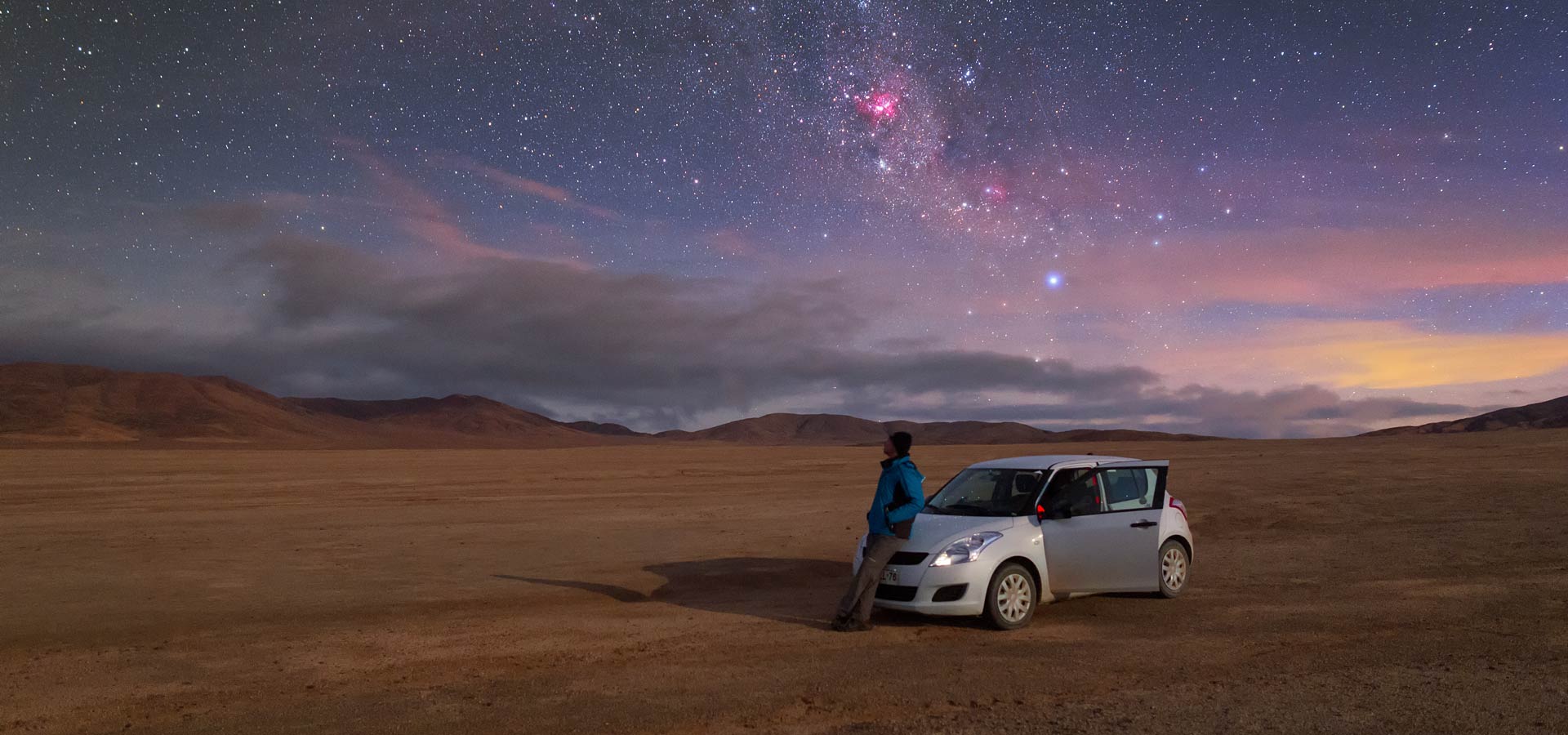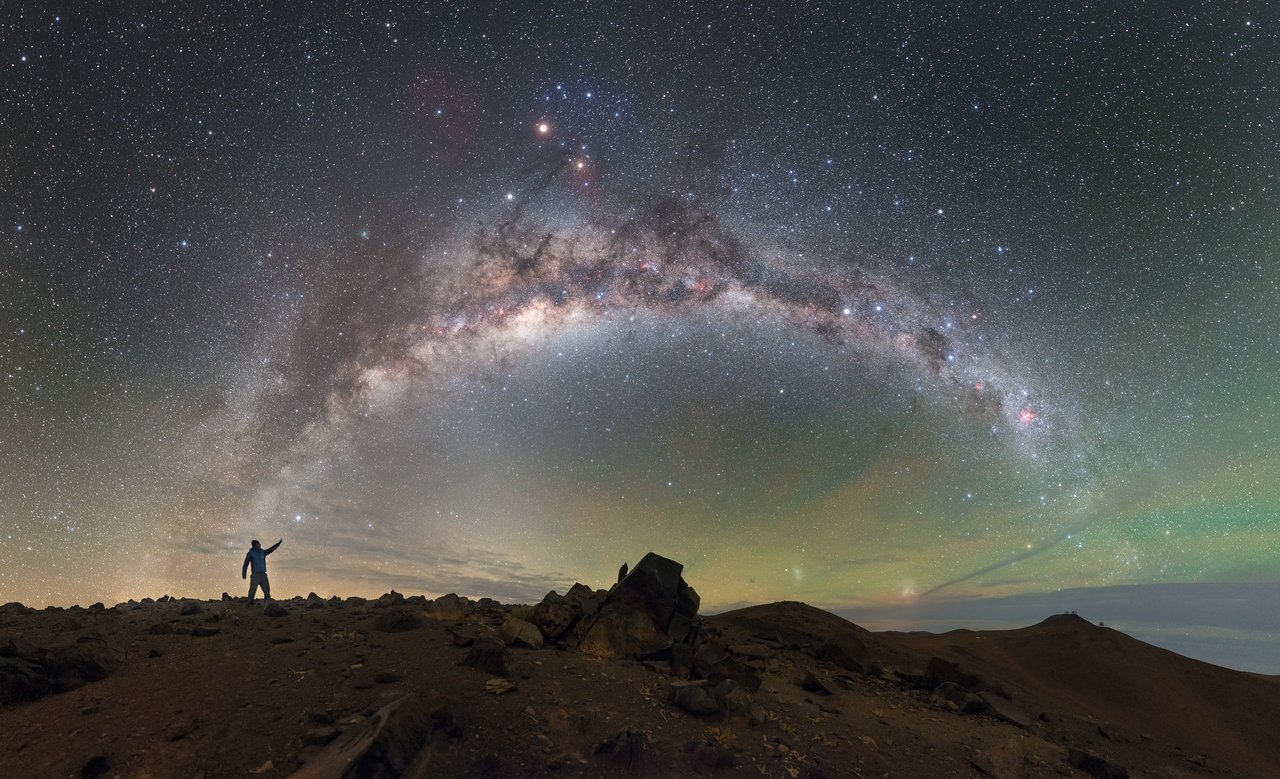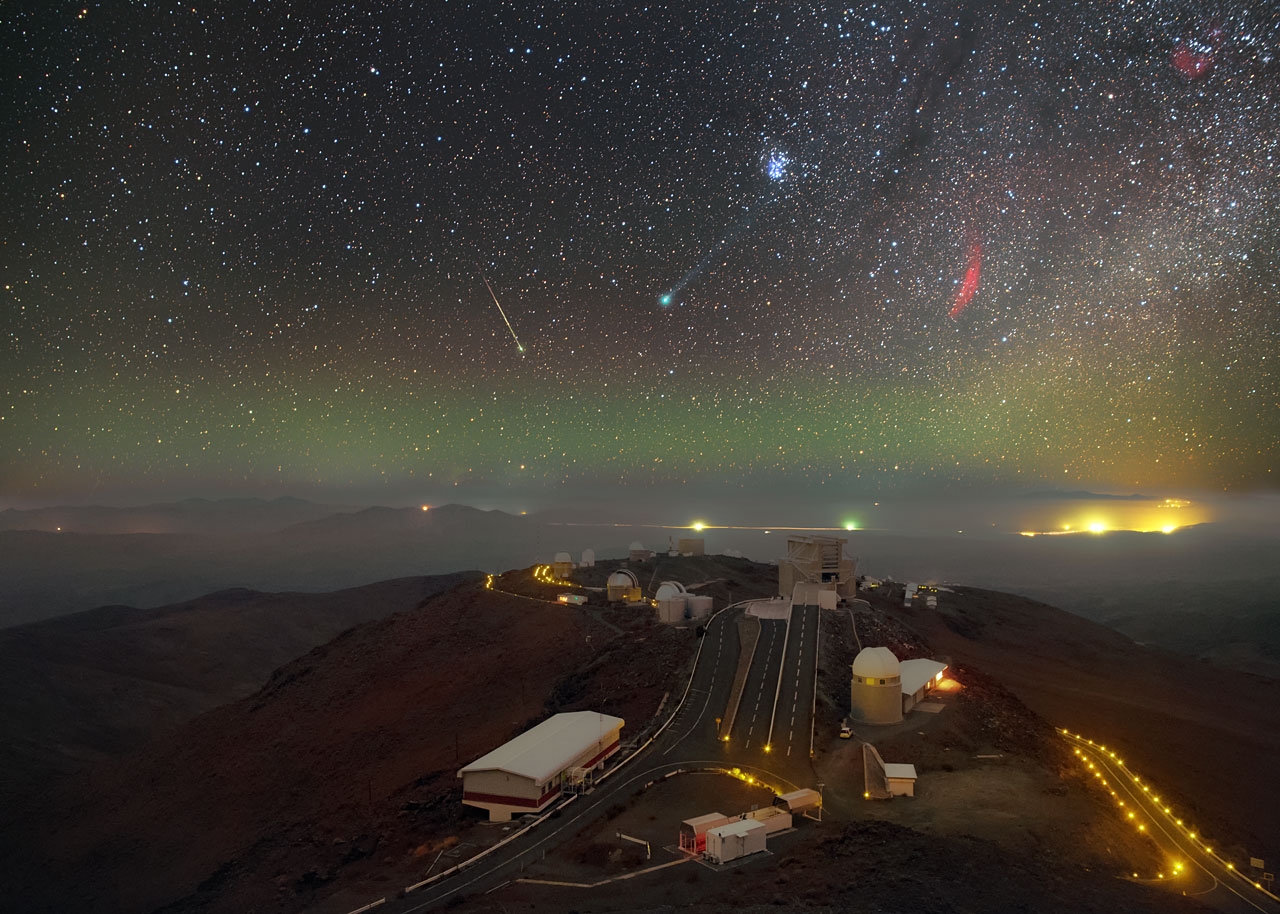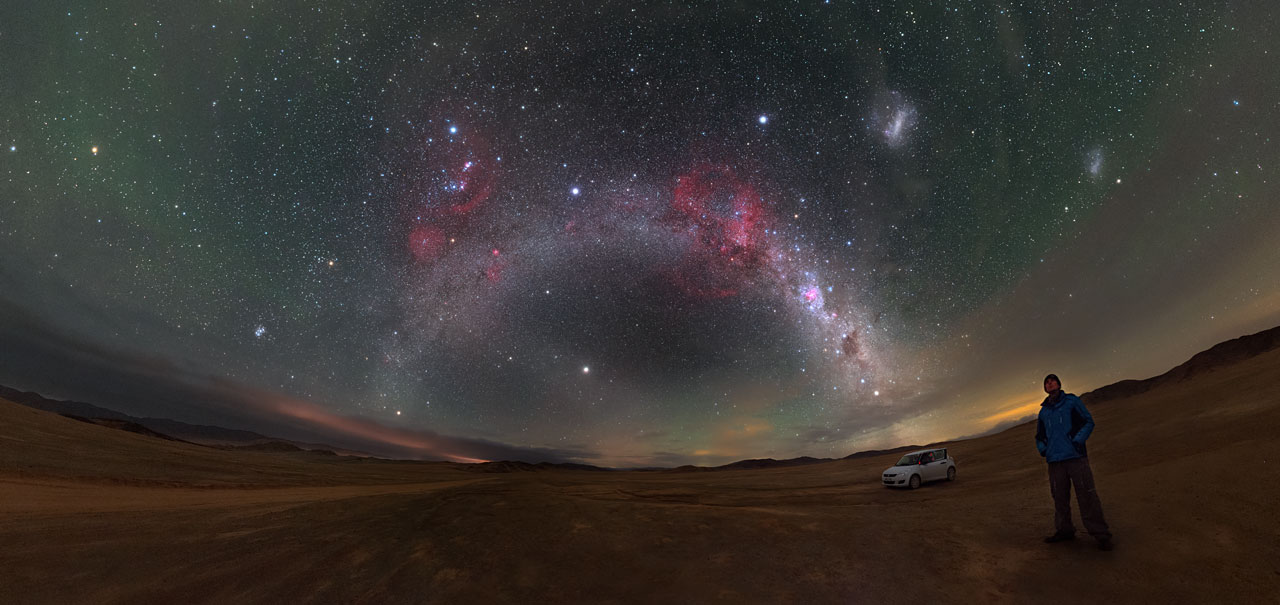- How ESO Photo Ambassador Petr Horálek first fell in love with the Universe
- The role astrophotography plays in connecting people to astronomy
- The growing problem of light pollution
- Petr’s seven “pearls of astronomy” and why you should experience them
Q: To begin with, why did you become interested in astronomy?
A: I was about 11 and I was spending my holiday at my grandparents’ cottage in the Iron Mountains in Czechia. I remember my grandmother brought me dinner, two rolls with honey, when I was drawing. I ate the first roll and she told me there was a beautiful view of the Big Dipper in the sky. I didn’t know anything about the Big Dipper or about stars, so I just walked outside to see it with her. She showed it to me but I didn’t understand what was so amazing about it. I was still hungry so I went back to eat the other roll, and while I was eating, my grandmother took my pen and drew the Big Dipper’s shape on my drawing paper. Then I became a bit more interested because I finally saw the shape she mentioned. So after I finished eating, I went out to see the Big Dipper. But while I ate, the Big Dipper had moved in the sky. I didn’t understand why — I thought that all stars stayed in the same place except for the Moon and the Sun. That was the first question in my mind, so I started to look for a good book. I found books and a map of the sky, and in the next year I learnt everything I could about the sky. But I kept coming up with more and more questions, and that drove me to study astrophysics at Masaryk University of Brno.
Q: Why did you pick up astrophotography?
A: Astrophotography was a different story. While I was studying astrophysics at Masaryk University of Brno I actually started my first job as an observer of fireballs with the Astronomical Institute of Czechia, located in Ondrejov. I had to use a few cameras — not typical cameras, but cameras with film. The observatory was part of an international network that monitored meteors and calculated whether a cosmic rock fell to the ground or just burned up in the atmosphere. This was very important and exciting, but at times could be boring. The only thing I had to do was change the film every three or four hours and check the weather for undesirable changes, so I had a lot of time. But I earned some money so the first thing I was able to buy was a camera, and I actually tried to make a documentary about skies. I didn’t plan to be a photographer. But somehow I found out that the data for the time-lapses could be used for beautiful pictures, so I learned how to process the pictures, especially with huge help of Prof. Miloslav Druckmüller. This was in 2011. Now it’s been six years and I’m still going.
Q: From your experience, how can astrophotography be used for outreach?
A: It’s very easy — you just show people something they don’t notice every day. You can educate them about phenomena visible with just the naked eye, or even things that can only be seen with telescopes or cameras. With photography you can explain the structure of the Milky Way galaxy and show people what we are missing in light-polluted cities. You can show them something that is very fast, like the green flash or red sprites, that are very difficult to see with your eyes.
I think it’s the same thing with microbiology. When you use a microscope to show people the details of something like a tardigrade or a snowflake, you open their eyes to something they can’t see in their everyday lives. Astrophotography just does this on a bigger scale. You can show people what’s above them, what’s surrounding them. You can show them the physical reality of the Universe they usually aren’t aware of at all.
Q: What is light pollution and why do you photograph areas of the world without it?
A: Light pollution is an extremely significant environmental problem. Of course, it’s not only about the stars. Light pollution is so strong that it also affects people’s health, nocturnal animals, the world’s economy and even traffic.
The first people who noticed the issue of light pollution were astronomers. The thing is, even if you travel 100 or 200 kilometres away from a bigger city, light pollution still influences your view of the sky due to the light scattering off what is in the air. In fact, 80 percent of the world’s population lives under artificial skyglow. At one Czech school, where I was invited as a guest to their class, the children told me they thought the Milky Way is just science fiction or cannot be seen from the Earth. This is horrible, considering the generation of my parents could experience it even from centre of middle-sized cities. Unfortunately, light pollution increases about six percent every year.
A lot of light pollution comes from lamps. Many cities and households use lamps where the light goes everywhere — and more than 70 percent of the light shines somewhere nobody actually needs it. If people used lamps that direct the light, so the light points downward or where you really need it, then light pollution would significantly decrease. Also, not everywhere has to be lit up all night. Another problem also comes with new LED lamps, which have a strong white colour that is dangerous to sleeping habits. I would suggest visiting the Dark Sky Association website to learn more about the problem of light pollution.
Q: Tell us about your “pearls of astronomy”. What are they and why do you capture them?
A: Back in 2003, I was an assistant observer of comets in Czechia. My mentor was astronomer named Martin Lehký. He focused mostly on comets and variable stars, but he was fascinated by everything in astronomy. He told me that he had a list of seven pearls of astronomy, which are the seven most beautiful, most remarkable phenomena in the sky. Those seven pearls are:
- A supernova in our galaxy
- A meteor rain (a strong shower of more than a thousand meteors per hour)
- A transit of Venus in front of the Sun
- A very bright comet
- The northern lights
- A total lunar eclipse
- A total solar eclipse.
I’ve been lucky because I have seen most of them, except the bright supernova and the bright comet. Those seven pearls are phenomena that can be enjoyed by everyone and are something people will remember for dozens of years afterwards, or even for a lifetime. They really affect you. Looking through a big telescope at the Moon’s craters, Saturn’s rings or a bright nebula is a beautiful experience, especially if you’re very far from cities, but these seven pearls are something you can enjoy even without a telescope. I call them “pearls” to show people that there are phenomena that they can enjoy even if they aren’t astronomers at all.
Q: What has been your most awe-inspiring moment as an astrophotographer?
A: The most amazing moments? Of course, the first thing that comes to mind is the total solar eclipse. It’s probably the most beautiful phenomenon — not just among astronomical phenomena but natural phenomena in general. A friend of mine, Václav Knoll, who unfortunately passed away, used to say that the total solar eclipse is the only phenomena in the sky that always receives an applause. Especially for the people who haven’t seen it before, they’re just amazed by what’s going on. They always stare at the sky with an open mouth, no breath, no sound. They don’t believe that this spectacle was created by nature without any human influence. The nine total solar eclipses I’ve witnessed have been the most breathtaking phenomena I’ve seen.
As an astronomy enthusiast, I’ve had many wonderful moments just under the southern skies — especially with the centre of the Milky Way above my head, which is not visible in Europe because it does not rise much above the horizon. I remember the first time I really felt a deep connection was when I saw the centre of the Milky Way in the Cook Islands in 2010. I just laid on the beach and waited for the dark skies. I couldn’t believe I could see the Milky Way as I knew it from the pictures. But you can see all the structures and all the wonderful parts of the galaxy with nothing but your own eyes. I’m so happy I became a Photo Ambassador for ESO and I could see it again in Chile and take photos of it. All of those photos carry the feeling of my first wondrous moment seeing the Milky Way in the southern hemisphere.
Q: What does it mean to you to be an ESO Photo Ambassador?
A: It’s a really big honour to me. There are many reasons why, but one of the biggest reasons I feel so honoured is because I’m the first Czech ESO Photo Ambassador. I never thought this could happen, but I’m so happy it did because this is the best way I can continue my fight against light pollution in my country and around the world, bringing people’s attention to the problem of light pollution using images taken at ESO’s observatories and showing them that beautiful skies really do exist. I’m also proud to be a Photo Ambassador because ESO is one of the biggest organisations in the world focused on astronomy research and technology development. To be part of something that big blows me away every time.
Q: What pushes you to continue astrophotography after so many years?
A: This is very easy. I’ve captured almost nothing. There are so many things you can capture in the sky. Of course, you have to wait for special conditions, sometimes even a lifetime. Some phenomena are very short like red sprites, and some are rare like supernovae. Even if you image every part of the night sky an infinite amount of times, you would still have infinitely many opportunities to capture a unique combination of phenomena. There are really still so many things to photograph.
Q: Anything you’d like to add?
A: I want to deeply thank everyone who supported me with crowdfunding after my equipment was stolen in Argentina. I really appreciate it and hope my pictures can act as a thank you for your support. Some of the images I’ve taken with new equipment since the robbery are downloadable in full resolution from the ESO archive. Many more are about to come. Thank you all!
Numbers in this article
| 6 | The mean percentage that light pollution increases globally every year |
| 7 | Pearls of astronomy |
| 9 | Number of total solar eclipses Petr experienced between 1999 and 2017 |
| 11 | Petr’s age when he became fascinated by astronomy |
| 80 | The percentage of the world’s population living under artificial skyglow due to light pollution and cannot experience the natural night sky |
| 2011 | The year Petr took up astrophotography |
Links
- ESO Photo Ambassadors
- Petr’s ESO image archive
- Petr’s photos featured for ESO’s Photo of the Week
- Petr on Facebook
- Petr’s Instagram
- Petr’s own web gallery
- Petr on Google+
- ESOcast 88: Fulldome Specialists visit Chile
- The ESO Messenger: Light Phenomena Over ESO’s Observatories I: Airglow
- The ESO Messenger: Light Phenomena Over ESO’s Observatories II: Red Sprites Seen from Paranal and La Silla
- The ESO Messenger: Light Phenomena Over the ESO Observatories III: Zodiacal Light
Biography Petr Horálek
Petr Horálek is a world-renowned astrophotographer, writer, traveller, and astronomer who represents ESO as a Photo Ambassador. After studying Theoretical Physics and Astrophysics at Masaryk University in Brno and working as an astronomer, he fell in love with astrophotography and took a year-long trip around the world to improve his skills. This trip took him into the heart of the Atacama Desert at ESO’s La Silla and Paranal Observatories in 2015. Petr continues to pursue astrophotography, capturing “pearls of astronomy” to share with the public. Email: phoralek@partner.eso.org

